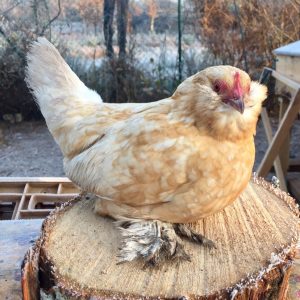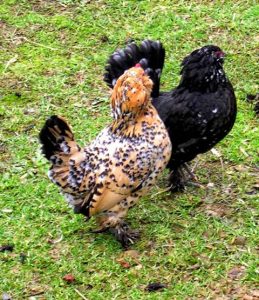Overview
Barbu d’Uccle is a Belgium breed of bantam chicken which was first recorded in the early 20th century, the name means from the area of Uccle. Michael Van Gelder spent many years developing these chickens in the municipality of Uccle in Belgium, it is understood that he bred the Dutch Sabelpoot and the Dutch Barbu d’Anvers to create this bird but no one can’t be certain as their lineage is a secret.
The breed was first recognized by the American Poultry Association (APA) in 1914. This breed is considered fairly rare and nearly found itself extinct after WWI.
The males can weigh up to 26oz (740g) and females can weigh up to 22oz (620g).
Eggs
Size
Small sized eggs
Color
Cream to white colored eggs
Production per year
100 eggs per annum
When do they start laying eggs?
Around 20 weeks old
Bearded d’Uccle Characteristics
Temperament / Are they good as pets?
This breed is especially friendly and love human contact. They’d make perfect pets for families. If you live in a warmer climate its best not to get this beard as their excess of feathers means they can’t tolerate heat well, same goes if you live somewhere that is especially rainy.
How do I tame “Bearded d’Uccle” chickens?
As they’re known to be friendly they’re easier to tame. When you first get your chicks handle them so they become used to human contact. Another great way of taming your chickens is to feed them out of your hand.
How many do I need to buy?
Two chickens is the absolute minimum when starting a flock, we recommend you have six chickens as a small flock.
How much space do they need?
These birds don’t mind confinement so need up from 25 square feet in their run, the more the better.
Will they mix with my other chickens?
Yes, they’re friendly birds and should mix well with other breeds.
Appearance
There are seven recognized colors of plumage which range from porcelain to black, the most popular variety recognized by the APA is the Millefleur, which is mottled. An upright tail that appears to be almost at a 90 degree angle to the ground and bright orangey red eyes.
Bearded d’Uccle chickens have a short neck and a very broad breast. They have a small single comb and strong, feathered legs.

Feeding
What should I feed them?
From 0-6 weeks your chicks should be feed growers mash, this is a refined type of chicken feed which is easier for them to digest and has a 19{cfcd481556a8b43fba6af451761032bd323e94372a0c1e607} protein content to give them all the nutrients they need to grow.
Once they hit 6 weeks you can switch them to a pelletized form of chicken feed which has a lower protein content (15-16{cfcd481556a8b43fba6af451761032bd323e94372a0c1e607}).
At 18 weeks you should gradually introduce layers mash or pellets, this has 16{cfcd481556a8b43fba6af451761032bd323e94372a0c1e607} protein and will give them everything they need to lay eggs. Bantam chicken food as its commonly refered to is infact smaller pellets than the usual size. Again this is commonly called by most chicken feed producers Bantam pellets.
How much should I feed them?
As these are bantam chickens they need less food than standard sized chickens, try starting with 60g or 2oz of feed and then change the amount based on how much they’re eating. You can either feed them at breakfast and dinner but most leave feed in the feeder for them to eat all day.
What can’t they eat?
There are lots of things that you shouldn’t feed your chickens that you can find on our chicken feed page. The main two are chocolate and beans.
There is theobromine in chocolate which can result in cardiac arrest. Similarly dried and raw beans has phytohemagglutinin which can be fatal once ingested.
In the UK you can’t feed them chicken scraps as it is against the law. Moldy food needs to be kept away from chickens as mold can make them very unwell.
What do I need to keep chickens?
Chickens need a coop that is 1.1m2 or 11 square feet per chicken. In the coop there should be a perch for each of them to sleep on at night, there also needs to be separate wooden boxes that you should fill with wood shavings where the hens can lay their eggs.
Try and place your chicken coop in the shade. You should put a fence all the way round and over the top of the coop, the fence should be sunk at least 8 inches into the ground. Your chickens need somewhere to exercise, so have a run for them that has 25 square feet per chicken.
Grit is really important in helping your girls lay eggs, keep some always accessible so they can help themselves to it. Water should also always be accessible for you chickens, buy a water container that can’t be knocked over or stood into and keep it out of direct sunlight.


